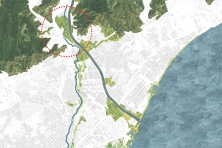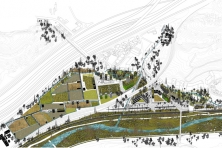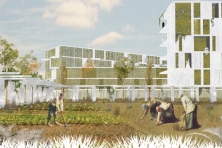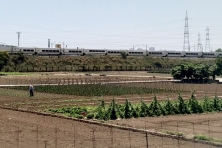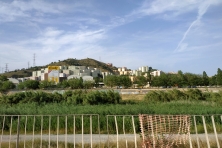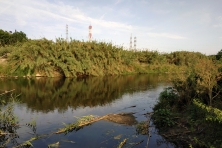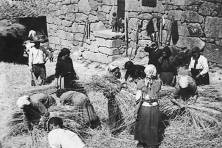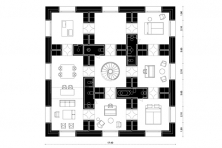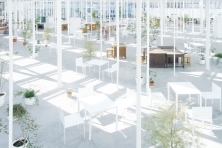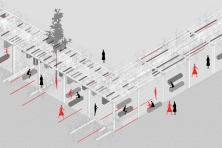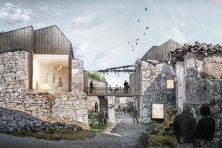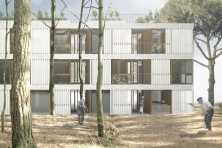Overlapping Vallbona
Barcelona (ES) - Runner-up
TEAM DATA
Team Representative: Javier Rocamonde Lourido (ES) – architect urbanist; Associates: Natalia Alvaredo López (ES) – urbanist; Corentin Berger (FR), Adrián Río Lado (ES) – architects; Emmanuelle Blondeau (FR), Gemma Milà Cartañá (ES) – architects urbanists; Léonard Cattoni (FR) – landscaper
Passeig de Montjuïc 32/34 2° 2ª, 08004 Barcelona (ES)
+34 646 286 273 - taller@bivaque.net – bivaque.net
See the complete listing of portraits here
See the site page here

Top: N. Alvaredo López, A. Río Lado, E. Blondeau & C. Berger || Bottom: J. Rocamonde Lourido, L. Cattoni & G. Milà Cartañá
VIDEO (by the team)
INTERVIEW
1. How did you form the team for the competition?
We are a multidisciplinary group formed of architects, urbanists and landscapers merged into a team to participate on various sites proposed to Europan 15. Some of us had already collaborated on projects and competitions; however, Europan 15 was the first time for the complete team.
We firmly believe that translating some of the global discussions (e.g. The productive city) to a local context is key to address urban planning and architectural proposals in a contemporary context; and therefore, having such an international and diverse team was an advantage. The fact of having team members directly involved in the architectural circles of Barcelona and Paris allowed us to work on three different sites (Vallbona, Sant Climent and Romainville) from a generic discussion and to get to very specific and local proposals for each site.
2. How do you define the main issue of your project, and how did you answer on this session main topic: the place of productive activities within the city?
In the case of Vallbona, the productive city has certain singularities. On one hand, Barcelona has always been a productive city. Despite the intent to push the heavy industry and the factories out of the city during the 70s, the mixed-use areas remained very active in almost all the metropolitan area. However, it is true that nowadays the production is centered in services and in the knowledge industry. On the other hand, Vallbona represents a unique opportunity to keep the primary production within the city, considering the fertile land of La Ponderosa and other productive systems of great environmental and heritage importance, such as the Rec Comtal and its irrigation system, the Ritz Farm, the torrent Tapioles...
We can find different systems and different spatial and time scales on our site. We firmly believe we should take advantage of this overlapped realities and intensify the latent urbanity in Vallbona. To do so, it is crucial to get over the romantic view of the productive city linked to naïve interpretations of the Garden City related to sustainability and production. In our opinion, a productive urban area is where production (both material and knowledge) and socialisation merge together, boosting cooperative processes with the potential to transcend the narrowness of the production of vegetables as a rallying cry of the productive city. On top of that, if we include complementary activities and collective spaces, public facilities and housing, the result is a diverse urban fabric with a mix of uses and users, and in summary, a space with an intense urbanity.
We consider that the key of the contemporary city lies in the right balance of the triad Housing–Socialisation–Production, and we approach this discussion from a multi-scale analysis: from the territory to the domestic spaces and vice versa.
Vallbona as a space for opportunities
A new neighbourhood in the Besòs valley
Domestic common spaces to dwell, socialise
and produce
3. How did this issue and the questions raised by the site mutation meet?
Vallbona is, or could be, a hyperconnected node of the metropolitan area, and this is an important fact to take into consideration. At the moment, the site is greatly affected and disrupted by general transport systems like the railways and the highway, and rather than denying this fact, the interventions in Vallbona should take it as an opportunity to connect the site with the metropolitan area and incorporate all the benefits of these interconnectivities.
Following the same principle, we didn’t try to hide or modify these infrastructures, as these alterations are neither viable at this moment, nor required to be addressed by the E15 brief. Nevertheless, an optimum density of housing, activities and users could make a new train platform connecting Vallbona with the city centre within a few minutes viable and desirable. We should also bear in mind that one of the reasons why the site is not at its full potential (despite the number of proposals from the 70s up to nowadays) is that unfortunately, it is difficult for the local government to explain and propose an ambitious project for an area with a low density of residents.
Additionally, the re-densification of Vallbona required in the E15 brief is the perfect occasion to improve the connection between the site, the Besòs and the opposite riverside whilst transcending the neighbourhood scale of our site.
La Ponderosa: the last large agricultural plot
Ecotones of the Besòs river
The River Besòs as an opportunity
4. Have you treated this issue previously? What were the reference projects that inspired yours?
We have been reflecting on these topics in both the academic and the professional world. We validated the hypothesis that, at least in our context, the triad Housing–Socialisation–Production was present as a mixed-use concept in buildings and settlements up to the industrial revolution in almost all the human habitats. However, during the industrial revolution the spaces acquire a hierarchy and a deep specialisation according to their use, leading to the zoning of buildings and cities. Recently, we have started to appreciate how these hierarchies and borders between zones (uses) and users are becoming diffuse and volatile again. On the other side, the old dichotomies rural vs urban and public vs private (probably the two keystones of the 20th-century urbanism) have been surpassed long ago to explain the city and the territory.
Considering all the above, we are interested in the hybrid territories and in the multifunctional common and ambiguous spaces that characterised most of the traditional architectures and cultural landscapes. We strongly believe that these spaces are great references to face some of our contemporary challenges without dismissing the 21st-century perspective and other colleagues work.
Traditional Common Spaces to dwell, socialise
and produce © José Suarez (1932). A malla.
Generic Isometric Grid to dwell, socialise
and produce © Tuñón Arquitectos
(2015-2018). Stone house in Cáceres (ES)
Appropriable common space © Junya
Ishigami + Associates (2008). Kanagawa
Institute of Technology Workshop
5. Urban-architectural projects like the ones in Europan can only be implemented together with the actors through a negotiated process and in time. How did you consider this issue in your project?
We acknowledge that a project with this level of complexity can only be implemented with the consensus and the input of a wide range of agents. Therefore, we conceive our proposal as an open project, as a hypothesis that can represent a starting point to trigger the discussion and the work with the rest of the agents. We synthesised our intentions under six strategies leading to various projects devised to be implemented in phases designed around participative processes. We believe these processes are more important than the projects themselves.
To show how we imagine these processes, we proposed a strategy based on a hybrid governance (bottom-up and top-down) aiming to empower the neighbours’ decisions making without resting importance to the leading role of the public administration.
6. Is it the first time you have been awarded a prize at Europan? How could this help you in your professional career?
Yes, this is the first time we have been rewarded at the Europan competition. We think this prize could be a good opportunity in terms of media impact, but especially, we consider Europan as an almost unique occasion to work with autonomy on large scales and complex projects being under 40 years old.
TEAM IDENTITY
Office: We don’t have a legal status as a team, a shared name or a unique postal address. Up to the moment, we worked with temporary teams and in a non-hierarchised structure. We form a specific team according to the nature of the project or competition we are going to face, and this organisation give us a versatile structure. Following this approach, we have been able to work in different countries in a short period of time, aiming to achieve a local response informed by global perspective.
For E15, the team was formed by the following offices and individuals: BIVAQUE, Datum Arquitectura, Emmanuelle Blondeau, Léonard Cattoni and Atelier Berger Mila.
Functions: Architecture, Urbanism & Landscape
Average age of the associates: 33 years old
Has your team, together or separately, already conceived or implemented some projects and/or won any competition? If yes, which ones?
In the last years, some of us have been rewarded in a number of competitions, for ex. 3rd prize at the Concurso para la remodelación de la Plaza de los Belgas en Collado Villaba, Madrid (ES), 2018; Finalist at PALIMPSESTO, Concurso para a rehabilitación de construccións para vivendas en Fondodevila, Ourense (ES), 2017; 3rd prize at FURNUYULUS, Concurso Living the Collective en Hornachuelos, Córdoba (ES), 2017; 1st prize at INVERNADA, Concurso para o Club náutico na Illa de Arousa, Pontevedra (ES), 2014, Winner (ex aequo) at AMUD, International competition Designing for Free Speech, New York (US), 2014.
In addition, we have collaborated with other practices in the conception and construction phases of projects and some of us have built or are in the process of building as well.
STOA (2018), 3rd prize - Plaza de los Belgas
competition, Collado Villalba. Madrid (ES),
by Taller Bivaque
PALIMPSESTO (2017), Finalist – Housing
competition, Fondodevila, Parada de Sil,
Ourense (ES), by Taller Bivaque, P. Ortiz
& B. Silva
LAR (2019). Residential building for aging
people competition, Ferrol, A Coruña, Santiago,
Pontevedra, Vigo and Ourense (ES), by Datum
Arquitectura, Taller Bivaque & J. Aguirre
